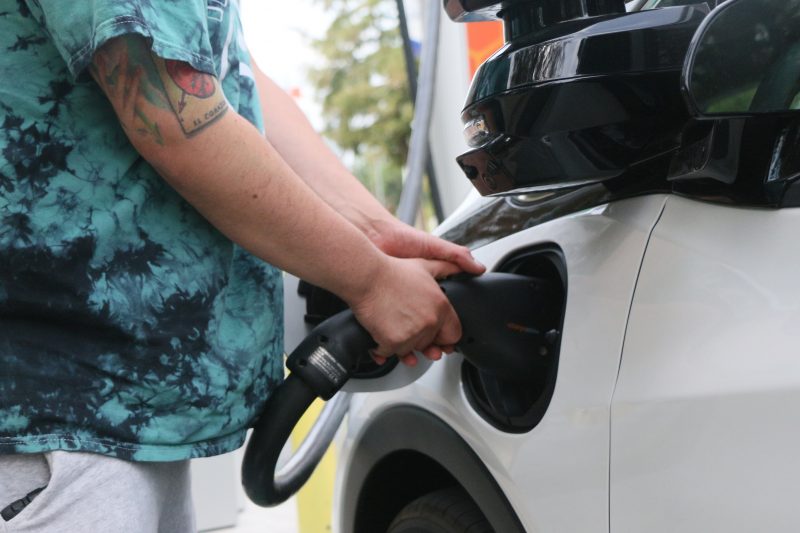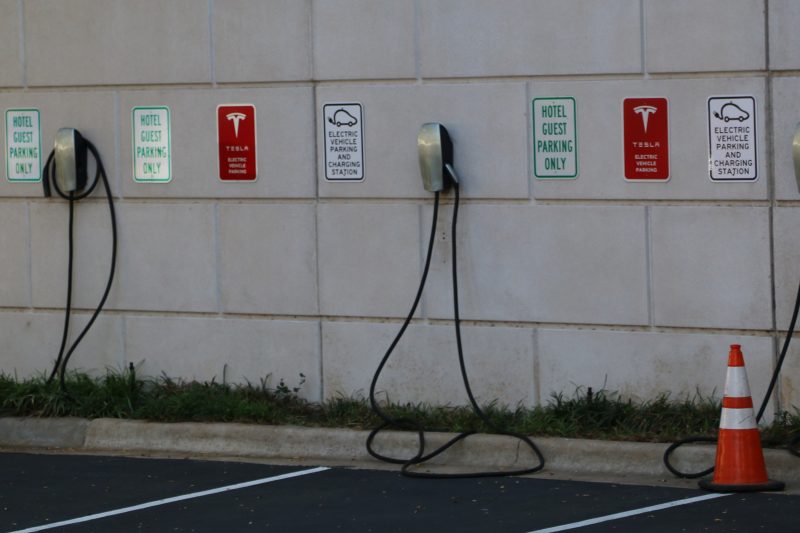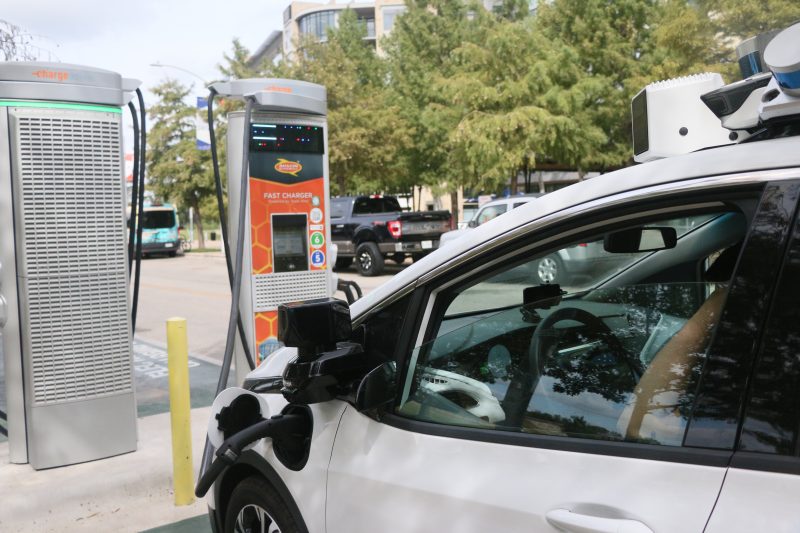Electric Vehicle Charging Set to Expand in Rural Texas in Next Five Years
By Jinpeng Li
Reporting Texas

A motorist charges an electric vehicle. Texas is installing more charging stations throughout the state after it received the most federal funding to improve EV infrastructure. Jinpeng Li/Reporting Texas
When Summer Xia drove to Florida for her first long-distance trip in a 2022 Tesla Model Y long range, she made sure to plan for charging the electric vehicle along the way. Tesla’s website calculated her planned route at 1,164 miles and told her there would be 10 Tesla Supercharger stations on the way.
“My husband has very serious range anxiety,” Xia said. “The battery would consume very quickly when you are driving the EV on the highway.”
They ended up charging the car four times along the way, with the Tesla automatically navigating to the nearest charging station each time its range was running low. Even though the trip was during summer vacation, Xia said there was no wait to charge the vehicle and it took 20 to 30 minutes to fully charge.

Charging stations await customers in Austin, Texas. Jinpeng Li/Reporting Texas
But not all trips go as smoothly as Xia’s, especially in rural parts of Texas where electric vehicle charging stations can be sparse, making it difficult to own an EV there or sometimes even to pass through on the way to somewhere else.
Texas is working to improve rural access to charging stations. The Federal Highway Administration in September approved $408 million to help the state government to install EV charging stations along designated alternative fuel corridors. Those corridors are along interstate highways, such interstates 10, 20 and 35.
Texas received the most federal funding for the EV project through the Infrastructure and Investment and Jobs Act approved by Congress in 2021. California was second with an estimated $384 million for chargers.
“That amount was much more than anyone anticipated,” said Michael Chamberlain, director of data management at the Texas Department of Transportation. Chamberlain is responsible for planning the state charging station location project.
Thanks to the additional money, Chamberlain said, TxDOT was able to expand its plans for EV charging stations to more rural areas, in addition to the interstate highways, or Alternative Fuel Corridors.
At each charging station, the state plans at least four 150kW DC chargers, which are faster than the Level 2 chargers commonly used in homes. The DC units can charge some electric vehicles to 80% in about half an hour, making them ideal for long-range travel.
That will help to “remove the guesswork of trying to find the right or most probable route that travelers would take,” Chamberlain said.
Fiona Stone, owner of a Kia Niro EV, knows what that’s like. She said she ended up renting a vehicle for a trip from Dallas to Houston out of concern about charging stations. “I’m worried about being stuck in the rural areas,” she said.
TxDOT has not said when construction of the charging stations would begin, but it plans 55 charging stations within the first year of the project.

Carlos Gràcia works while waiting for his electric vehicle to charge last month in Austin, Texas. Now that it takes about 30 minutes or less to charge electric vehicles, their popularity has increased resulting in a need to place charging stations throughout the rural areas of the state. JInpeng Li/Reporting Texas
According to its Texas Electric Vehicle Infrastructure Plan, TxDOT will turn to stations in rural counties and small urban areas in the second year of its charger buildout. It intends to install at least one electric vehicle charger in all of the state’s 254 counties.
Electric vehicle ownership has spiked in Texas, tripling since 2020 and aided most recently by increases in gas prices. As of Nov. 8, data compiled by the North Central Texas Council of Governments showed 156,011 electric vehicles registered in Texas. More than half of them are Tesla. Chevrolet Volt and Nissan Leaf tied for second with 3.8% market shares.
But EV ownership lags in rural areas, said Chandra Bhat, a University of Texas engineering professor and director of the Center on Data-Supported Transportation Operations and Planning.
Vehicle owners in rural areas are more likely to opt for pickup trucks or other large vehicles that have not been available in EV models until only recently. Rural EV owners generally must rely on residential chargers to power their cars.
While the impact of these rural-based charging stations on people living in rural areas may be limited for now, they represent opportunity.
“The accessibility of the infrastructure will bring a wealth of opportunities to rural areas,” said David Correa, the city planner for Raymondville, a town of 11,000 in the sparsely populated area between Corpus Christi and Brownsville.
Raymondville is on TxDOT’s list to receive a charging station with six chargers in the first year of its buildout.
“It’s going to provide resources for our tourism and travel as well as our local citizens and provide electricity support for those EV owners who need to recharge,” Correa said.
More charging stations means more electricity demands for utilities, raising concern whether the rural grid can handle the future electricity demand caused by more EV use.
UT electrical engineering professor Ross Baldick says it will be important to expand the power capacity and replace aging components.
“Most parts of Texas are now well-served by electricity that can support large loads such as air conditioning,” Baldick said.
Large retail areas, such as Wal-Mart stores of Buc-ee’s gas stations, already are served with significant electrical capacity, making them likely locations for future charging stations.
TxDOT’s plan states that charging stations might be equipped with a combination of solar and battery equipment to supplement their power supplies. But Baldick noted that DC fast charging may lead to energy storage issues. When people charge their EV at high rates, they need more storage.
“Electricity is consumed at essentially the same time as it is produced, so any time difference between renewable production and needed consumption requires additional expenditure on storage,” Baldick said. “It remains expensive despite decreases in costs in recent years.”